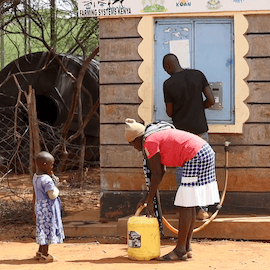Digital technologies have the potential to revolutionize the management and distribution of clean water. However, many low- and middle-income countries (LMICs) do not have access to these tools, creating a divide between nations that can adopt new technologies and those that cannot.
Bridging this digital divide in the water sector requires a multi-pronged approach, uniting the public and private sectors in an effort to leverage digital technologies to streamline operations and improve water access. Below, I’ll explore this challenge and discuss what water utilities in Kenya have learned from applying digital tools to optimize their work.
The Challenges of Digital Transformation in the Water Sector
Digital transformation is reshaping several industries, and the water sector is an essential area that could benefit from these developments. Innovations such as remote sensors, artificial intelligence and data analytics can help water utilities improve resource management and avoid addressing the imbalance between supply and demand solely by increasing water supply. By giving water utilities a better understanding of water supply and demand patterns, these technologies can help reveal inefficiencies and opportunities for the optimization of water usage, reducing losses, increasing reuse and informing more effective water management strategies. This is an essential function as the world suffers from intermittent precipitation patterns — something that’s virtually certain to worsen as the impacts of climate change continue to grow.
But climate change is just one of the challenges the water sector has faced over the past decades: Demand is increasing with population growth, while environmental deterioration and outdated systems are affecting the management and distribution of this essential resource.
These challenges are especially evident in LMICs, yet these countries also often lack the capacity to implement the digital solutions that could help address them. A lack of skills and knowledge are common hindrances to updating existing infrastructure and training staff to use new digital tools and systems. Economic barriers, such as poor funding and a lack of a clear return on investment for these projects, also affect the digitalization of water utilities in LMICs. And uneven internet access itself remains a key obstacle: A UN conference in 2023 revealed that although 63% of the world enjoys internet access, only 27% of the least developed countries’ populations are connected. This inequality in access to technology further reinforces existing social divides and leaves LMICs behind in adopting new solutions — both in the water sector and beyond.
Leveraging Digital Technology for Water Access: Lessons From Kenya
However, amid these challenges, some LMICs are gradually adopting digital technologies in their water utility systems. For example, Kenya’s water sector is embracing digital technology in its monitoring and payment architecture. Mobile payments, smart metering and other Internet of Things (IoT)-related solutions have enabled more efficient ways to automate these and other key water utility processes.
A recent report from GSMA has revealed five essential factors that may aid or hamper digital transformation in a country’s water sector — many of which can be seen in Kenya:
Leadership and Company Culture: Digital transformation often involves changes in an organization’s structure. Introducing new digital solutions can change or displace employees’ responsibilities, as many tasks they used to accomplish manually can now become automated. Strong leadership and positive company culture are essential during this transition to engage employees and ensure the project’s success.
Connectivity and Payment Infrastructure: Many digital solutions require internet connectivity — a factor that is essential to projects in Kenya, where digital transformation efforts have often leveraged the country’s advanced mobile and digital payment infrastructure. Mobile connections are necessary for smart meters and IoT devices to record detailed metrics and transmit information wirelessly. The country’s existing mobile networks and payment systems have also proven useful in digitizing payment collections, helping customers pay their bills even when cash offices are closed.
Funding: Financing is crucial in any development project. It can be especially challenging for projects that involve public entities like water utilities, where the profit motive might not be as clear for potential investors. With countries like the U.S. freezing foreign aid, nonprofits and LMICs relying on external funding might struggle to secure the finances necessary to pursue aid and development projects. However, other opportunities still exist for these projects: For instance, Kenya’s water utilities are exploring other financing options, particularly digitally enabled models based on revenue sharing.
Engaging With Tech Providers: Implementing new systems and digital technologies requires new hardware and software. Thus, organizations must cultivate relationships with tech providers and hardware vendors to establish and maintain their systems — something which can cause difficulties. For example, the utilities GSMA studied in Kenya faced challenges in sourcing equipment and assessing financial proposals from tech providers, since they lacked the right pricing benchmarks. The tech providers also found it challenging to work with utilities due to their slow decision-making processes and bureaucratic delays, which can stall payments and hamper a project’s progress. In response to these issues, some companies are adjusting their business models to offer smaller recurring payments (like those enabled by Software-as-a-Service approaches), which can make digital services more affordable to utilities while avoiding the delays common with larger payment cycles.
Governance and Strategy: Digital transformation is a multifaceted process that requires time and careful planning to implement effectively. Water utilities should make strategizing part of the project process, ensuring they have a clear timeline, goals and access to necessary resources. The Kenyan water sector has also identified the need for governments to establish strong guidance for digital transformation, ensuring high standards and knowledge-sharing among stakeholders.
The path to digital transformation in LMIC water utilities is already taking shape. Though the challenges to this goal are very real, current progress in countries like Kenya shows that committed leadership, well-designed financial and technological resources, and targeted guidance and support can help the sector overcome them. Building on what works and crafting tailored solutions to common obstacles can help LMICs leverage digital technologies to create more efficient and sustainable water systems that can support their populations — even in a time of growing water scarcity.
Ellie Gabel is a science writer specializing in environmental science, and the Associate Editor of Revolutionized.
Photo credit: Open Journalism Network by InOldNews
Publisher: Source link






